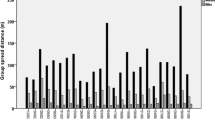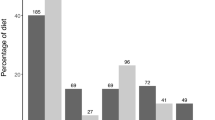Abstract
Decisions about when and where to travel are likely to have a strong influence on the feeding, ecology, and foraging strategies of individual primates living in a cohesive social group. Specifically, given differences in age, sex, reproductive status, or social dominance, particular group members may benefit from remaining at their present location while others may benefit from traveling to another area of their range to feed or rest. In this study, we present data on movement coordination in two groups of wild black and gold howler monkeys inhabiting Isla Brasilera (27º 20′S and 58º 40′W) in northern Argentina. We examine how factors such as sex, age, reproductive status, and dominance affect patterns of group movement coordination at feeding or resting sites, and in the context of intergroup encounters. Two groups were followed five days a month from sunrise to sunset during June to November 2004. Using focal and scan sampling techniques, we recorded 262 group displacements, the identity of the individual initiating and leading displacement, and the identity of the first individual to arrive at feeding, resting, or intergroup encounter sites. We found that overall age was the only factor that influenced group coordination: adults led more often (94.5 %) than immature individuals (5.5 %) in both groups. We did not find differences among adults. However, we found that males lead more often than females at intergroup encounters, consistent with the male-mate defense hypothesis. The distributed leadership pattern among adults observed in this study may suggest that adult individuals make equally shared consensus decisions. This pattern should be further examined using this individual-level approach in other populations of black and gold howlers, other species of howlers, and in other atelines in which within-group social tolerance is the rule rather than the exception.


Similar content being viewed by others
References
Altmann J (1974) Observational study of behavior: sampling methods. Behaviour 49:227–267
Barelli C, Boesch C, Heistermann M, Reichard UH (2008) Female white-handed gibbons (Hylobates lar) lead group movements and have priority of access to food resources. Behaviour 145:965–981
Bezanson M, Garber PA, Murphy JT, Premo LS (2008) Patterns of subgrouping and spatial affiliation in a community of mantled howling monkeys (Alouatta palliata). Am J Primatol 70:282–293
Boinski S (1991) The coordination of spatial position: a field study of the vocal behaviour of adult female squirrel monkeys. Anim Behav 41:89–102
Boinski S (1993) Vocal coordination of troop movement among white-faced capuchin monkeys, Cebus capucinus. Am J Primatol 30:85–100
Boinski S (2000) Social manipulation within and between troops mediates primate group movement. In: Boinski S, Garber P (eds) On the move: how and why animals travel in groups. University of Chicago Press, Chicago, pp 421–469
Boinski S, Campbell AF (1995) Use of trill vocalizations to coordinate troop movement among white-faced capuchins: a second field test. Behaviour 132:875–901
Boinski S, Garber PA (2000) On the move: how and why animals travel in groups. University of Chicago Press, Chicago
Bravo SP, Sallenave A (2003) Foraging behavior and activity patterns of Alouatta caraya in the northeastern Argentinean flooded forest. Int J Primatol 24:825–846
Brown AD, Zunino GE (1994) Habitat, density and conservation problems of Argentine primates. Vida Silvestre Neotropical 3:30–40
Byrne RW (2000) How monkeys find their way: leadership, coordination, and cognitive maps of African baboons. In: Boinski S, Garber P (eds) On the move. How and why animals travel in groups. University of Chicago Press, Chicago, pp 491–518
Conradt L, Roper T (2003) Group decision-making in animals. Nature 421:155–158
Conradt L, Roper TJ (2005) Consensus decision making in animals. Trends Ecol Evol 20:449–456
Crockett CM, Eisenberg JF (1987) Howlers: variations in group size and demography. In: Smuts BB, Cheney DL, Seyfarth RM, Wrangham RW, Struhsaker TT (eds) Primate societies. University of Chicago Press, Chicago, pp 54–68
Di Fiore A, Campbell CJ (2007) The atelines: variations in ecology, behavior, and social organization. In: Campbell CJ, Fuentes A, MacKinnon KC, Panger M, Bearder SK (eds) Primates in perspective. Oxford University Press, New York, pp 155–185
Di Rienzo JA, Balzarini MG, Gonzalez L, Tablada M, Robledo CW (2011) InfoStat. Grupo InfoStat, FCA, Universidad Nacional de Córdoba, Córdoba
Dias PAD, Rangel-Negrín A, Canales-Espinosa D (2011) Effects of lactation on the time-budgets and foraging patterns of female black howlers (Alouatta pigra). Am J Phys Anthropol 145:137–146
Erhart EM, Overdorff DJ (1999) Female coordination of group travel in wild Propithecus and Eulemur. Int J Primatol 20:927–940
Eskuche U, Fontana JL (1996) La vegetación de las islas argentinas del Alto Paraná. Folia Botanica et Geobotanica Correntesiana 11:1–15
Fashing PJ (2001a) Activity and ranging patterns of guerezas in the Kakamega Forest: intergroup variation and implications for intragroup feeding competition. Int J Primatol 22:549–577
Fashing PJ (2001b) Male and female strategies during intergroup encounters in guerezas (Colobus guereza): evidence for resource defense mediated through males and a comparison with other primates. Behav Ecol Sociobiol 50:219–230
Fashing PJ (2007) African colobine monkeys: patterns of between-group interaction. In: Campbell CJ, Fuentes A, MacKinnon KC, Panger M, Bearder SK (eds) Primates in perspective. Oxford University Press, Oxford, pp 201–224
Garber PA, Kowalewski MM (2011) Collective action and male affiliation in Howler monkeys (Alouatta caraya). In: Sussman RW, Cloninger R (eds) Origins of altruism and cooperation. Springer, New York, pp 145–165
Harris TR (2006) Between-group contest competition for food in a highly folivorous population of black and white colobus monkeys (Colobus guereza). Behav Ecol Sociobiol 61:317–329
Jacobs A (2010) Group cohesiveness during collective movements: travelling apart together. Behav Proc 84:678–680
Janson CH, Bitetti MSD (1997) Experimental analysis of food detection in capuchin monkeys: effects of distance, travel speed, and resource size. Behav Ecol Sociobiol 41:17–24
Janson CH, van Schaik CP (1993) Ecological risk aversion in juvenile primates: slow and steady wins the race. In: Pereira ME, Fairbanks LA (eds) Juvenile primates. Oxford University Press, New York, pp 57–74
Jolly A (1984) The puzzle of female feeding priority. In: Small MF (ed) Female primates: studies by woman primatologists. Liss, New York
King AJ, Sueur C (2011) Where next? Group coordination and collective decision making by primates. Int J Primatol 32:1245–1267
Kowalewski MM (2007) Patterns of affiliation and co-operation in howler monkeys: an alternative model to explain social organization in non-human primates (Ph.D. thesis). University of Illinois at Urbana–Champaign, Urbana
Kowalewski MM, Garber PA (2010) Mating promiscuity and reproductive tactics in female black and gold howler monkeys (Alouatta caraya) inhabiting an island on the Parana River, Argentina. Am J Primatol 72:734–748
Kowalewski MM, Zunino GE (2004) Birth seasonality in Alouatta caraya in Northern Argentina. Int J Primatol 25:383–400
Leca JB (2003) Distributed leadership in semi free-ranging white-faced capuchin monkeys. Anim Behav 66:1045–1052
Milton K (1980) The foraging strategy of howler monkeys: a study in primate economics. Columbia University Press, New York
Oklander LI, Kowalewski MM, Corach D (2010) Genetic consequences of habitat fragmentation in black-and-gold howler (Alouatta caraya) populations from northern Argentina. Int J Primatol 31:813–832
Overdorff DJ, Merenlender AM, Talata P, Telo A, Forward ZA (1999) Life history of Eulemur fulvus rufus from 1988–1998 in southeastern Madagascar. Am J Phys Anthropol 108:295–310
Petit O, Bon R (2010) Decision-making processes: the case of collective movements. Behav Proc 84:635–647
Prates HM, Bicca-Marques JC (2008) Age–sex analysis of activity budget, diet, and positional behavior in Alouatta caraya in an orchard forest. Int J Primatol 29:703–715
Pyritz L, Fichtel C, Kappeler PM (2010) Conceptual and methodological issues in the comparative study of collective group movements. Behav Proc 84:681–684
Pyritz LW, Kappeler PM, Fichtel C (2011a) Coordination of group movements in wild red-fronted lemurs (Eulemur rufifrons): processes and influence of ecological and reproductive seasonality. Int J Primatol 32:1325–1347
Pyritz LW, King AJ, Sueur C, Fichtel, C (2011b) Reaching a consensus: terminology and concepts used in coordination and decision-making research. Int J Primatol 32:1268–1278
Ron T (1996) Who is responsible for fission in a free-ranging troop of baboons? Ethology 102:128–133
Rumiz DI (1990) Alouatta caraya: population density and demography in northern Argentina. Am J Primatol 21:279–294
Sicotte P, MacIntosh AJ (2004) Inter-group encounters and male incursions in Colobus vellerosus in central Ghana. Behaviour 141:533–553
Sigg J, Stolba J (1981) Home range and daily march in a Hamadryas baboon troop. Folia Primatol 36:40–75
Smith AC, Buchanan-Smith HM, Surridge AK, Mundy NI (2003) Leaders of progressions in wild mixed-species troops of saddleback (Saguinus fuscicollis) and mustached tamarins (S. mystax), with emphasis on color vision and sex. Am J Primat 61:145–157
Sueur C, Petit O (2008) Shared or unshared consensus decision in macaques? Behav Proc 78:84–92
Valero A, Byrne RW (2007) Spider monkey ranging patterns in Mexican subtropical forest: do travel routes reflect planning? Anim Cogn 10:305–315
Van Belle S, Estrada A, Ziegler TE, Strier KB (2009) Sexual behavior across ovarian cycles in wild black howler monkeys (Alouatta pigra): male mate guarding and female mate choice. Am J Primat 71:153–164
Wang E, Milton K (2003) Intragroup social relationships of male Alouatta palliata on Barro Colorado Island, Republic of Panama. Int J Primatol 24:1227–1244
Wrangham RW (1980) An ecological model of female-bonded primate groups. Behaviour 75:262–300
Acknowledgments
We thank our field assistants, collaborators, Escuela Comunitaria Guacara, local people at Isla del Cerrito, Estacion Biologica Corrientes, Museo Argentino de Cs. Naturales “B Rivadavia,” and CONICET. This study was funded by The Graduate College—UIUC (MK), The Wenner-Gren Foundation (grant no. 7034; MK), The Leakey Foundation (MK), IdeaWild (MK), and the American Society of Primatologists (MK). We would also like to thank Luz Arias for helping us with the figures, Charlotte Bender and Emma Boston for helping with the manuscript, and Romina Pavé for her comments. VAF thanks Pablo Arístide for his unconditional support. The study complied with the current laws and permissions of Argentina and the United States (IACUC protocol 01071). We also want to say thank you to one anonymous reviewer and Dr. Lennart Wolfgang Pyritz for their insightful comments.
Author information
Authors and Affiliations
Corresponding author
About this article
Cite this article
Fernández, V.A., Kowalewski, M. & Zunino, G.E. Who is coordinating collective movements in black and gold howler monkeys?. Primates 54, 191–199 (2013). https://doi.org/10.1007/s10329-013-0342-x
Received:
Accepted:
Published:
Issue Date:
DOI: https://doi.org/10.1007/s10329-013-0342-x




